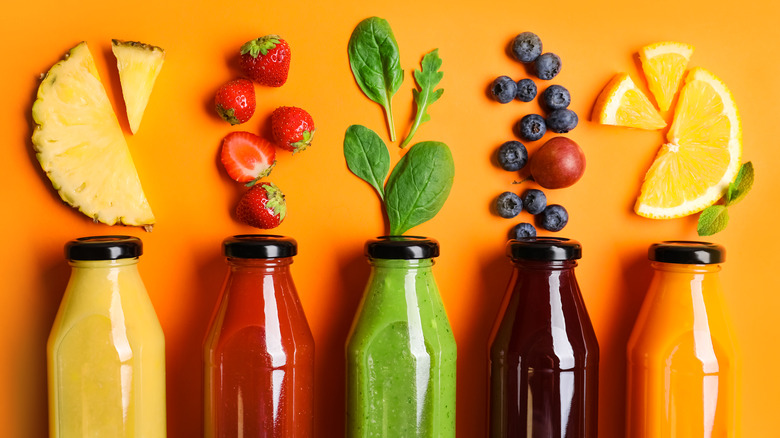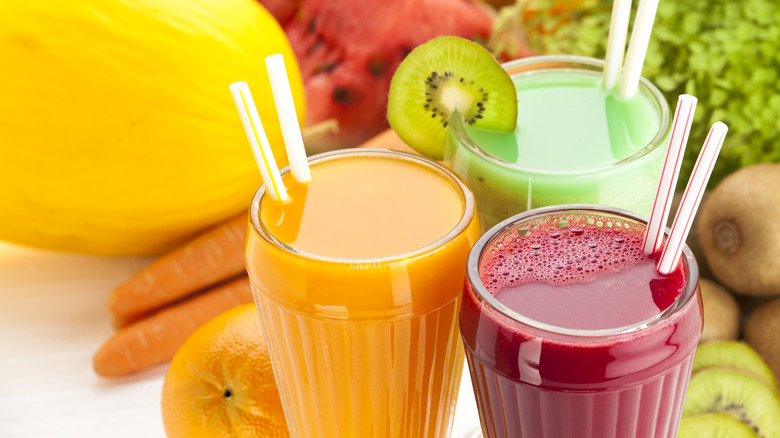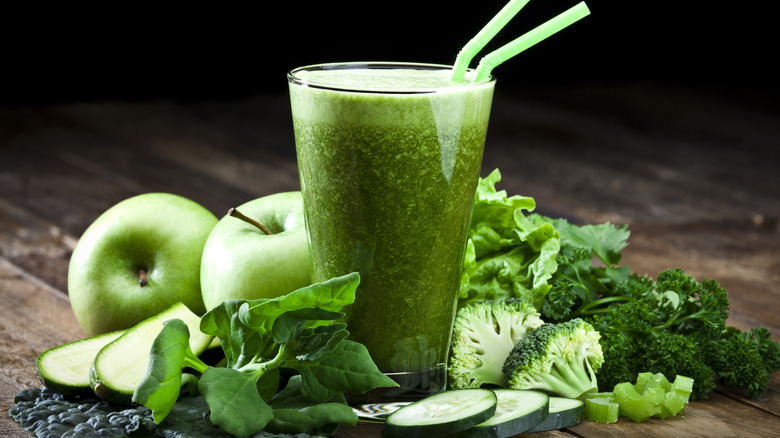For Delicious Homemade Juice Every Time, You Need To Get Creative
If you're looking for an easy breakfast or midday source of fuel on the go, making your own juice could be worthwhile. Unlike lackluster or over-sweetened store-bought juices, DIY juice is fresh, flavorful, completely customizable, and you can take it with you straight from home to wherever you go. Plus, if you're struggling to get more fruits and veggies into your diet, homemade juice will help do the trick.
Once you have quality produce and a favorite way to squeeze juice — whether by blender, juicer, or even by hand — the only tricky part is creating a good balance of flavors. If you throw random fruits and veggies into a blender, you'll wind up with a drink that looks and tastes muddy. Instead, follow a formula for choosing ingredients that create a rich flavor and nutritional profile. For a balanced flavor, you'll need one or two sweet items, usually fruit. Counteract that sweetness with something tart or sour. Citrus is an obvious choice, but rhubarb is a more exciting addition that adds tartness and a lovely color.
For added nutrients, use leafy greens (such as kale or spinach). The fruits should brighten those earthier flavors, making the juice more palatable (and pretty) than one made of mostly greens. Finally, for a pop of brightness or a twist of unexpected flavor, try adding herbs like fresh parsley, a little jalapeño, or a pinch of your favorite spice. These elements will combine into a juice that's unique, complex, and satisfying.
How to build the perfect juice
The basic combo of sweet, sour, and earthy or green elements should make a tasty juice, but you still need to make an effort to choose produce that complement each other. Choose one or two "standout" flavors and keep the rest of your ingredients mild. Some fruits and veggies are more assertive than others and can create a clashing and unbalanced flavor when combined.
If you want a green juice with lots of veggies, sweeten it with apples — they have a high juice yield and a refreshing flavor but aren't so sweet that they'll clash with the vegetal, herbal flavors of leafy greens. If you don't want to taste the greens as much, mango, pineapple, and oranges are possible partners. A mix of these can make your juice more sweet and fruity, while still tasting harmonious.
As for the ratio, stick to the 3:1 method, which means three parts vegetables to every one part fruit. This prevents the drink from being too sugary and ensures you're getting a balance of nutrients. If you want something less veggie forward, you can use a 2:1 veggie-to-fruit ratio or a 2:3 fruit-to-veggie ratio, but most experts recommend using fewer fruits than veggies to limit sugar intake, which could cause a spike in blood sugar. If you prefer a veggie-heavy drink, a 5:1 ratio of veggies to fruit might be more your taste.
How to make and store your own juice
There are two major benefits to making your own juice: cost and ingredients. Store-bought fruit juices can run as much as $5 per serving, and drinking one every day gets expensive. Buy your fruit and veggies fresh and you'll save money. Plus, making your own juice ensures you know its exact ingredients, so you can target the nutrients and flavors you're looking for.
Once you remember the ratio and choose your ingredients, making the juice is easy. There are a few things to watch out for, though. Inspect your fruits to ensure there aren't soft spots and that everything is ripe; the same goes for the state of your veggies and leafy greens. For example, remove any spinach leaves that show signs of rot. And make sure you know whether you should juice a fruit with its skin on or off. Apple skins have nutrients and don't negatively impact flavor, whereas adding a banana skin to your juice will give it a bitter, undesirable taste. (Don't worry there are plenty of ways to use those leftover banana peels.)
If you want to make juice in bulk, keep in mind that freshly squeezed juices will only stay good for about three days in the refrigerator. You can freeze them for up to 16 months, though. A quick tip for fruit juice: Freeze it in ice cube trays, so you can take a small amount as needed to add to your drink.


